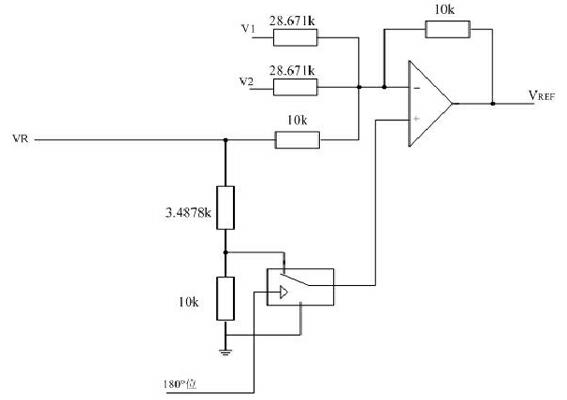Method for converting digital signal to synchro/rotary transformer signal
A resolver and self-aligning machine technology, applied in the direction of instruments, electric/magnetic devices to transmit sensing components, measuring devices, etc., can solve the problems of popularization and application in the field of unfavorable angle measurement and control, single output type and frequency, and poor adaptability and other issues, to achieve the effect of wide operating frequency, multiple output types, and strong adaptability
- Summary
- Abstract
- Description
- Claims
- Application Information
AI Technical Summary
Problems solved by technology
Method used
Image
Examples
Embodiment 1
[0019] Embodiment 1, with reference to Figure 1-5 , a method for converting digital signals to auto-synchronizers / resolvers. The circuit for realizing the method includes a digital-sincosine signal conversion circuit and an electronic SCOTT transformer. The digital-sincosine signal conversion circuit can be subdivided into high 3-bit coarse points The circuit and the lower 13-bit subdivision circuit receive 16-bit natural binary digital angle and a reference signal with a frequency of DC ~ 1kHz, and generate a high-precision 6.81V sine-cosine signal to the electronic SCOTT transformer. The electronic SCOTT transformer passes through different jumper methods. Realize line-line voltage 11.8V auto-tuner signal, line-line voltage 11.8V resolver signal or line-ground voltage 6.81V sine-cosine signal output. The conversion method achieves the highest conversion accuracy of ±1 arc minute, the signal frequency range is DC to 1kHz, and the output signal type is programmable from synch...
Embodiment 2
[0020] Embodiment 2, in the digital signal described in embodiment 1 to the autosynchronizer / resolver conversion method: the described digital-sincosine signal conversion circuit divides the 16-bit digital quantity θ into α and β two Part, α is the upper 3-digit rough fraction angle: 0°, 45°, 90°, 135°, 180°, 225°, 270°, 315°, one of the 8 values, that is, the circumference is divided into 8 etc. β is the subdivision digital angle of the lower 13 digits: 0°~(45°-1LSB), that is, the fan in the range of 0~45° is divided into 211=8192 equal parts, 1LSB=0.055°; digital-sincosine signal conversion circuit Therefore, it can be subdivided into the upper 3-bit rough division circuit and the lower 13-bit subdivision circuit to realize various items related to α and β, and finally obtain the sine-cosine signal in the range of full-angle "α+β".
Embodiment 3
[0021] Embodiment 3, in the digital signal described in embodiment 1 or 2 to the synchro / resolver conversion method: in the high 3-bit coarse division circuit of the digital-sincosine signal conversion circuit, the 180 ° control bit is passed through the analog switch and precision resistors to realize the inversion of the reference signal, so as to realize the output of sine and cosine signals to Switching; K is the effective value of the signal line-ground voltage; the 45° control bit realizes the mutual switching between sinβ and sin (45°-β) through an analog switch; the 45° and 90° control bits generate sinα through an analog switch and a precision resistor network, The function values of cosα, sin(α+45°) and cos(α+45°) can be used to realize the sine-cosine function value of four quadrants with a total of 8 rough points.
PUM
 Login to View More
Login to View More Abstract
Description
Claims
Application Information
 Login to View More
Login to View More - R&D
- Intellectual Property
- Life Sciences
- Materials
- Tech Scout
- Unparalleled Data Quality
- Higher Quality Content
- 60% Fewer Hallucinations
Browse by: Latest US Patents, China's latest patents, Technical Efficacy Thesaurus, Application Domain, Technology Topic, Popular Technical Reports.
© 2025 PatSnap. All rights reserved.Legal|Privacy policy|Modern Slavery Act Transparency Statement|Sitemap|About US| Contact US: help@patsnap.com



